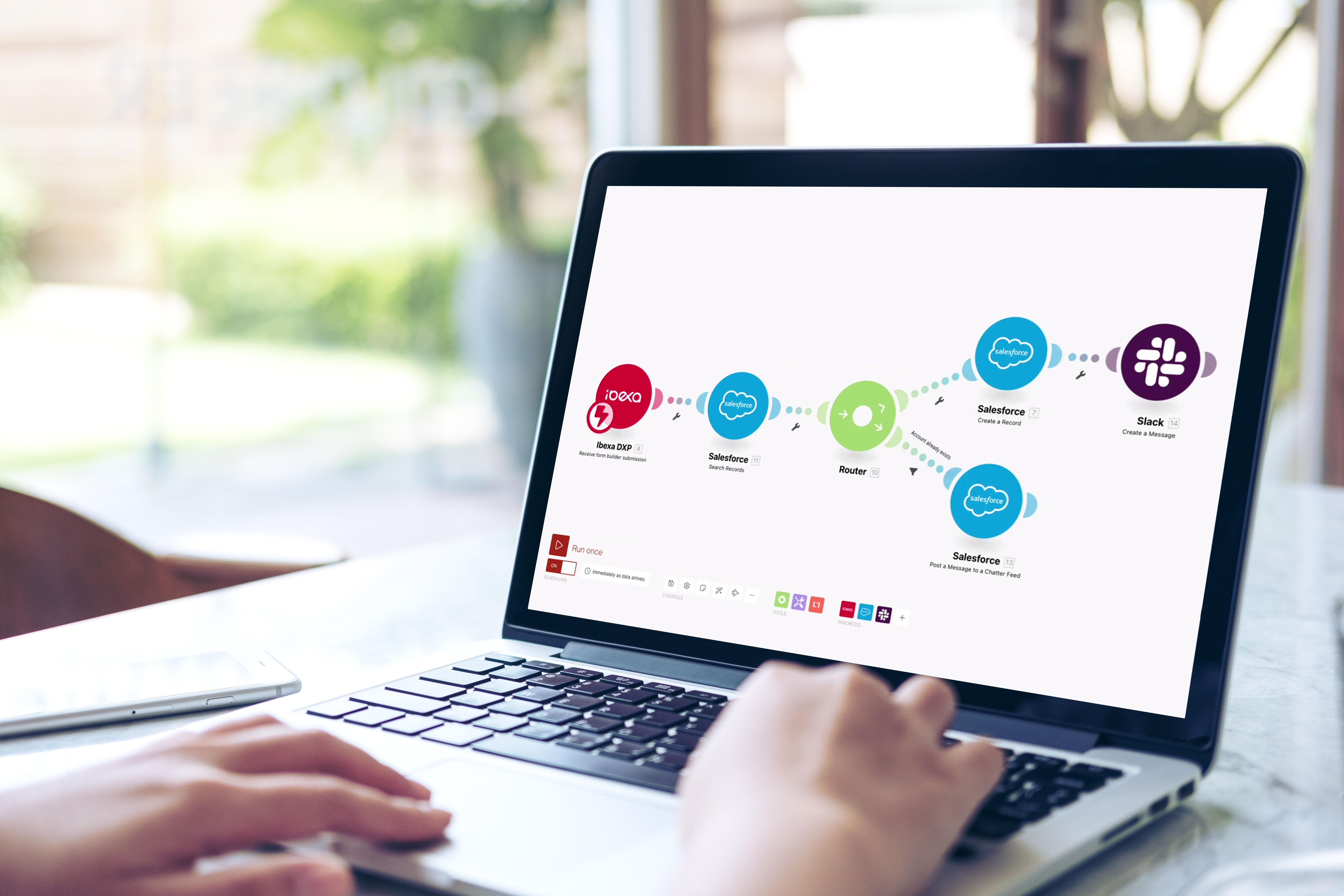9 B2B Ecommerce Solutions and Strategies to Boost your Online Sales

Are you searching for B2B ecommerce solutions and strategies to help boost your digital performance and increase online sales? Well, look no further!
In this article, we examine nine essential B2B ecommerce strategies that will help your business take the next step in its digital transformation. We also explore how you can use our modular B2B Digital Experience Platform (DXP), to implement these strategies.
What is B2B ecommerce?
Put simply, B2B ecommerce is the process of businesses marketing, buying, and selling products to and from other businesses via digital channels. While the B2B sector may have been slower to adopt ecommerce models and initiate digital transformation strategies, it is catching up quickly.
In fact, a recent Gartner survey revealed that “83% of B2B buyers prefer ordering or paying through digital commerce.”1 This is complemented by research from McKinsey that shows 65% of organizations across industry sectors now offer B2B ecommerce capabilities.
Discover why B2B ecommerce is no longer a hard sell in our free and exclusive eBook...
What are the main differences between B2B and B2C ecommerce?
Though it may seem like B2B and B2C ecommerce solutions fulfil a similar function, they do so in drastically divergent ways. This is due to significant differences between the sectors. These differences include:
The buyer – B2C buyers are usually individuals. In contrast, B2B buyers are groups, teams, or entire departments that make purchasing decisions collaboratively.
Buyer journey - The B2B buyer journey is non-linear, far longer, and considerably more complex. This is partly because there are more people involved in decision-making. But it also comes down to the amount of information B2B buyers need to make a purchase. When you consider that the typical buying group for a complex B2B solution involves six to 10 decision makers‚ each armed with four or five pieces of information, it becomes clear just how complicated B2B buying can be. The B2B buying cycle is also continuous with reoccurring orders which can make it more predictable. Whereas for B2C, individual orders are more spontaneous.
Purchase rationale - Traditionally, B2C buyers are perceived to be motivated by emotion and impulse, while B2B buyers are driven by logic and data. However, in recent years, there is greater recognition that emotion and impulse play small yet significant roles in B2B purchasing.
Product and process - Whereas B2C buyers focus primarily on product, B2B buyers are just as interested in the process of working with a supplier. They want to know that product support, ordering, and communication will all be seamless. Every B2B process has a cost. And buyers are aware that systems which do not support B2B commerce requirements can negate any benefits associated with an excellent product.
Product complexity - B2B products tend to be far more complex than in B2C. Typically, there are multiple variations due to diverse sizing specifications, dimensions, colors, and a range of technical data, parameters, and attributes. As a result, any high-quality B2B ecommerce solution must account for product complexity.
Pricing - B2B pricing is usually tailored to individual customers based on several factors, including the order size, the buyer-seller relationship, and the region. This contrasts with B2C, where the price is simple, a standard price which only varies based on discounts and promotions. B2B suppliers also work with much higher order values.
Key B2B ecommerce solutions and strategies
To boost online sales, you must implement effective B2B ecommerce strategies. Below, we examine nine essential strategies that will help you improve your ecommerce performance.
1. Customize your product portfolio to individual customers
Not all your customers will be interested in every product you offer. Most will have unique needs and focus on a small part of your product portfolio. To maximize ecommerce success, you must adjust and customize your portfolio to ensure you present customers with relevant products.
Ibexa DXP facilitates this by enabling you to create varied product catalogs which you can utilize in different circumstances. You can target catalogs at specific customer groups, use them at certain times of the year, or build them to appeal to regional markets. This feature ensures you advertise your products in the most effective way possible.
As you do so, be sure to design catalogs based on the data available to you. Analyze which products interest particular customer groups, and whether certain products are regularly bought together. Modern analytics allows you to remove the guesswork and make informed decisions, so be sure to make use of that information.
2. Break down customer data silos
Similarly, B2B organizations need a full picture of the customer to make considered, data-driven choices. The more holistic a view of customer behavior you have, the more effectively you can refine your ecommerce operations.
A Customer Data Platform (CDP) is one of the best tools for breaking down customer data silos and ensuring you have a 360° view. In modern B2B organizations, customer data comes from multiple sources. McKinsey research shows that “B2B customers often use ten or more channels to interact with suppliers (up from just five in 2016).” As a result, you must incorporate behavioral data from a wide array of channels if you are to truly address the customer’s needs.
3. Recommend the right products
Upselling is a crucial aspect of B2B ecommerce. In the digital space, it is best achieved via intelligent product recommendations. Product recommendations make the most of customer data (collected and informed by your CDP) and algorithms to show product recommendations.
In Ibexa DXP, suppliers have two options. You can recommend products based on a machine learning-driven algorithm and your customer profiles. Or you can manually set the recommended products list for a particular customer group. This gives you complete control over what additional products your customers see as they progress through the buyer journey.
As a B2B company with a lot of product variety, it’s important to display only the most relevant items to each customer profile, this can be achieved through customized product catalogs and data-driven product recommendations. Both are powerful ways of increasing online sales whilst simplifying and enhancing the buying experience.
4. Create corporate portals
One of the key differentiating factors between B2B and B2C ecommerce is the former’s focus on the buyer-seller relationship and business processes. To maximize online sales, you must implement features that streamline buyer-seller interactions and empower organizations to collaborate and communicate more effectively.
Corporate portals are an excellent example. They allow for closer collaboration between team members, supplying a space where team members can work together on critical business processes. For instance, multi-level approval in the buying process presents many challenges. Getting the necessary approvals is often a slow and cumbersome process.
Corporate portals can streamline and regulate this process by alerting individuals when they need to approve a purchase or resolve an action. They can also set restrictions to ensure only authorized employees can place an order or add spending limits.
These portals are the foundations of one of the most exciting and promising trends in B2B ecommerce, the Digital Sales Room. The Digital Sales Room aims to provide B2B suppliers and buyers with an online environment that facilitates the entire sales process. From requesting product information and talking to sales reps to negotiating prices, placing orders, and signing contracts, all conducted via a single dedicated digital portal.
5. Segment your customers for a more effective, personalized experience
We have already emphasized the need to target content at specific customers and deliver personalized customer experiences. One of the principal ways of achieving this is via customer segmentation according to shared characteristics and behaviors, enabling you to push relevant content and shape the buyer journey to reflect their needs.
For instance, with Ibexa DXP, you can segment customers to identify those you have not interacted with for a certain period. This could include customers that have not placed their typical re-order or not responded to outbound emails. As a result, you can group and target customers you are at risk of losing, to minimize customer churn rates.
As segmentation depends on access to extensive customer data, your CDP will play a significant role in acquiring and providing the information you need. As you can see, many of these strategies are interdependent. In this case, to effectively segment your audience you need to break down data silos and achieve a 360° view of the customer.
6. Take advantage of custom pricing to deliver value
Custom pricing permits you to set prices for different customer groups depending on customer loyalty, order value, region, and any other defining segment feature. As noted in the B2B vs B2C ecommerce section, B2B pricing is often remarkably complex and tailored to individual customers.
Factors such as purchase volume and pre-negotiated discounts, buying frequency, so suppliers need a B2B ecommerce solution that offers complete control and easy adjustments. Ibexa DXP features extensive price control and customization functionality, so your ecommerce store can supply all the flexibility you need.
7. Customize your content for unique customer experiences
In the B2B environment one size doesn’t fit all. Personalized experiences ensure customers engage with your digital resources in ways that build interest, foster engagement, and deliver value.
As the buyer journey is long and complex, it is necessary to target customers multiple times with specific content. Buyers who are conducting research need to see different information than those close to making a purchase. Though this type of content may not seem as though it is intrinsic to ecommerce operations, it plays a crucial role.
The fact that content and commerce are tied together is demonstrated by the way sales and marketing teams are combining and their responsibilities overlapping. Likewise, the rise of the Digital Sales Room shows that marketing and sales functions are taking place in the same space.
In Ibexa DXP, the Page Builder feature ensures you can customize content to specific audiences and guarantee content relevance. Via targeted content blocks, you can create pages that adapt to different customer groups and display varied content depending on the audience's preferences, needs, and behaviors.
8. Adopt technology that allows easy integration
In the omnichannel business environment, integrations are vital. B2B business systems are complex, and data comes from numerous sources. Your CDP helps extract customer data from different solutions. But what about the other information?
In many instances, B2B organizations build native integrations to connect their ERP, CRM, or PIM solutions. However, this is time-consuming, complicated, and is likely to result in additional work in the future. Ideally, you need a solution that reduces the need for native integrations, and ecommerce must also be integrated into company processes which includes customer relationship management, customer service management, after-sales service, invoicing, inventory management, deliveries, order management, and custom product catalogs.
In Ibexa DXP, Ibexa Connect acts as our iPaaS solution. It allows for a quick and easy integration without extensive development or coding expertise. In doing so, it simplifies connections, enables you to map integrations, and streamlines workflows.
9. Guarantee your customers’ security
In the B2B sector, trust is everything. Historically, buyer-supplier relationships were defined by a close relationship between sales agents and customers. While the digitalization of the sector has changed the nature of these relationships (there is far less person-to-person communication), trust is still a key issue.
For instance, your customers need to know your ecommerce solutions are secure. A single data breach can be catastrophic, tarnishing your reputation and causing a drop in online sales. As a result, you must implement ecommerce solutions that emphasize digital security, and keep your customers and their data safe.
Ibexa DXP was designed with security at its heart. Combining security measures established by existing tools with our engineering team’s rigorous peer review process, we guarantee a secure ecommerce environment for all users.
Ibexa DXP - the leading B2B ecommerce solution
Our unique Digital Experience Platform (DXP) is designed to support the needs of B2B organizations. Capable of transforming traditional sales processes into seamless digital experiences, it enables you to bring together every aspect of your B2B ecommerce strategy and control marketing and sales operations via a single, intuitive platform.
A comprehensive B2B ecommerce solution, its modular design ensures you can scale the platform as your business grows, empowering you to add additional features and functionality when you need them. For more information on how Ibexa DXP can help your business, check out the Ibexa DXP product page, view our success stories, or get in touch with our team of experts.
Discover how we can help you with your Digital Transformation
Book a meeting with an Expert
Let's talk about how we can help you. From a 15-minute discovery call to a short demo of our technology, we can advise and recommend the right solution at all stages of your digital transformation.



